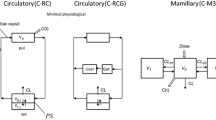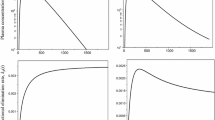Abstract
The radioactivity disappearance curves of glucose-6-14C albumin-I131 after a single injection of tracer into a human subject have been determined in detail, particularly at early time intervals. The curves, expressed as sums of exponentials, have been analyzed as the infinite sum of convolutions of single passage time densities. The resultant transfer time distribution of a single circulatory pass allows examination of all delays in the system no matter how long they take. The structural detail evident by this means and the long mean time of a single pass of glucose (>5 min) supports the thesis that factors other than rapid and uniform diffusion play a role in the extravascular movements of glucose molecules.
Similar content being viewed by others
Literature
Berman, M., E. Shanan and M. F. Weiss. 1962. “The Routine Fitting of Kinetic Data to Models: A Mathematical Formalism for Digital Computers.”Biophysical J.,2, 275–287.
Cox, D. and H. Miller. 1965.The Theory of Stochastic Processes. New York: Wiley and Sons.
Goresky, C. A. and G. G. Bach. 1970. “Membrane Transport and the Hepatic Circulation.”Ann. N.Y. Academy Science,170, 18–47.
Hart, H. E. 1967. “Analysis of Tracer Experiments: VIII. Integro-differential Equation Treatment of Partly Accessible, Partly Injectable Multicompartment Systems.”Bull. Math. Biophysics,29, 319–333.
Landis, E. M. and J. R. Pappenheimer. 1963. “Exchange of Substances Through the Capillary Walls.” InHandbook of Physiology, Cir.,2, 961–1034.
Robertson, J. S. 1957. “Theory and Use of Tracers in Determining Transfer Rates in Biological Systems.”Physiological Reviews,37, 133–154.
Segal, S., M. Berman and A. Blair. 1961. “The Metabolism of Variously C14-labeled Glucose in Man and an Estimation of the Extent of Glucose Metabolism by the Hexose Monophosphate Pathway.”J. Clin. Invest.,40, 1263–1279.
Sheppard, C. W. 1962. “Basic Principles of the Tracer Method.” New York: Wiley and Sons.
Stephenson, J. L. 1960. “Theory of Transport in Linear Biological Systems: I. Fundamental Integral Equation.”Bull. Math. Biophysics,22, 1–138.
Waterhouse, C. and J. Kemperman. 1966. “Changes in Oxidative Metabolism with Glucose Ingestion.”J. Lab. Clin. Med.,68, 250–264.
—, N. Baker and H. Rostami. 1969a. “Effect of Glucose Ingestion on the Metabolism of Free Fatty Acids in Human Subjects.”J. Lipid. Res.,10, 487–494.
—, and J. Keilson 1969b. “Cori Cycle Activity in Man.”J. Clin. Invest.,48, 2359–2366.
Zierler, K. 1962. “Circulation Times and the Theory of Indicator-Dilution Methods for Determining Blood Flow and Volume.” InHandbook of Physiology, Cir.1, 585–615.
Author information
Authors and Affiliations
Additional information
This study was supported by Public Health Service Grants CA 07123 from the National Cancer Institute and RR 00044 from the Division of Research Facilities and Resources, N.I.H.
Rights and permissions
About this article
Cite this article
Waterhouse, C., Keilson, J. Transfer times across the human body. Bulletin of Mathematical Biophysics 34, 33–44 (1972). https://doi.org/10.1007/BF02477022
Received:
Issue Date:
DOI: https://doi.org/10.1007/BF02477022




